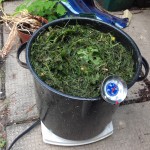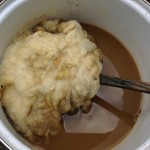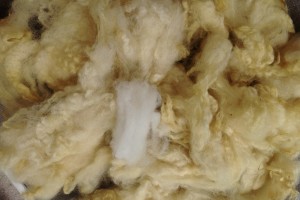
Summer is the time for natural dyeing. This is dyeing, not with commercial dyes, but with materials I can find around where I live such as flowers or lichen. It’s always interesting to try new plants and see if I can get colour from them.
The most common colour from plants is yellow and I have been trying to find a nice source of green. I had heard somewhere that grass clippings give green so after the gardeners had mowed our condo lawns for the first time this year I collected a pot full of grass clippings with a bunch of dandelions. I soaked them in water overnight and the next day I heated the pot on a hot plate in the back yard and brought it to a boil. I simmered for an hour and the water was now a yellowish green. I carefully strained off the grass through cheesecloth and had just dye liquid left.

Most, but not all natural dyes need a mordant to allow the colour in the plant to properly fix itself to the wool. Mordants are usually metals and the one I use is alum. I use potassium aluminum sulfate but grocery store alum used for pickling also works. Different mordants such as tin or iron can produce different colours from the same dyestuff but some, like chrome, are extremely dangerous and I don’t use them. Some people soak their wool in a solution of water an the mordant before dyeing but I am lazy and just add the mordant to the dyepot.
I put about 6 ounces of washed Romney wool into the dyepot and let it simmer for an hour or so. It was a pale yellow and not very exciting so I let it simmer for another hour. Still pale yellow. So I turned off the heat and just left the wool in the dyepot overnight.
The next morning the wool was still pale yellow so I took it out and gave it a thorough rinsing and put it out to dry. It’s not a bad colour but there are much better yellow dyes available, although later in the summer. I love goldenrod, red clover and cedar clippings.

My next experiment was with lilac flowers, which I had also heard might give green. I followed the same procedure as for the grass clippings and got – you guess it – pale yellow.
